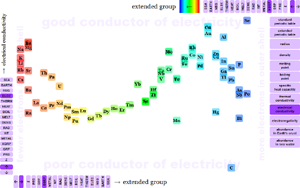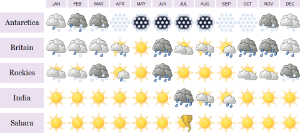Nuclides
| number of protons |
| number of neutrons |
| number of nucleons |
| isotopic mass |
| binding energy |
| half-life |
| abundance |
Notes
This representation of 3137 nuclides shows the bundles of protons and neutrons that make up most of what we think of as matter
If you took a bunch of protons and neutrons, the chances are they'd want nothing to do with each other. Protons, after all, are positively charged, so tend to stay away from each other. However, at the enormous energies found inside stars, protons and neutrons come close enough that the long-range, repulsive electromagnetic force between the protons is overwhelmed by the short-range, attractive, strong nuclear force, which brings the protons and neutrons together to form the nuclides shown here.
Most of these 3137 nuclides are unstable. Click on the binding energy property on the chart and you'll see just how unstable: most of the nuclides would decay in less than 10 seconds. A few combinations, however, are stable: 2 protons and 2 neutrons, for example, might stay together forever as a helium-4 nuclide; 92 protons and 146 neutrons will most likely last billions of years as a uranium-238 nuclide before splitting up.
Such stable nuclides can form the nuclei of atoms. The positively-charged protons attract an equal number of negatively-charged electrons, forming atoms of hydrogen, helium and all the other elements that make up our world.
If these nuclides can only be created at the enormous energies found inside stars, where do the nuclei of all the iron, silicon and magnesium atoms that make up the Earth come from? Indeed, where do all the oxygen, carbon and nitrogen nuclei that make up our bodies come from?
The answer is simple and mind-boggling. The nuclides that make up our world were created in stars billions of years ago. These stars exploded as supernovae; the detritus from the explosions was thrown out into space; and from this dust of nuclides the solar system, the Earth and the humans that walk upon it were formed. If you ever wondered what little boys and little girls are made of, it is the remains of dead stars.
Every inch of this visualization is active. Move your mouse over a nuclide to show its symbol, properties and further information. Or move your mouse over a property to show a representation of the value of that property for each of the nuclides. Click on a control to hold it down, then click elsewhere to release it.
Subscribe now and I’ll let you know whenever I create a new visualization
It’ll only be every couple of months or so, I won’t let anyone else have your email address, and you can unsubscribe at any time
Thanks for subscribing!
Check your inbox for an email to confirm your subscription
Oh no, something went wrong, and I was unable to subscribe you!
Please refresh your browser and try again
More
This is one of a series of visualizations of what things are made of, from elementary particles to organic molecules…
Nuclides – this page
…check back soon for the next in the series
Latest things made thinkable
Sources
Wikipedia – Isotopes of hydrogen, helium, lithium, etc.
Brookhaven National Laboratory – National Nuclear Data Center – Atomic Mass Adjustment
University of Waterloo – Chung Chieh – Nuclide Stability
National Institute of Standards and Technology – Fundamental Physical Constants
Text
A text summary of this presentation is shown below for easy reference
Properties
nuclides
Nuclides are the bundles of protons and neutrons that form the nuclei of atoms and make up most of what we think of as matter.
number of protons
The nuclides that form the nucleii of atoms have one or more protons: hydrogen atoms have 1 proton, helium atoms have 2 protons and uranium atoms have 92 protons. However, three of the nuclides on this chart have no protons at all, only neutrons: 1n is 1 neutron, 2n is 2 neutrons and 4n is 4 neutrons. These nuclides, however, are not the nuclei of atoms, since without positively-charged protons, they cannot attract the negatively-charged electrons that make atoms atoms.
number of neutrons
Nuclides tend to have about the same number of neutrons as protons. Indeed, the most common isotopes of helium, carbon, nitrogen, oxygen and several other light elements have exactly the same numbers of protons and neutrons. Heavier nuclides, however, tend to have more neutrons than protons. That's why this chart, which plots the number of extra neutrons against the number of protons, slopes upwards.
number of nucleons
The number of nucleons is simply the number of protons plus the number of nucleons.
isotopic mass
The mass of an atom is the sum of the masses of the protons, neutrons and electrons that make it up, right? Well, not quite. When protons and neutrons come together to form nuclides, they lose a little mass; and as we know from Einstein's famous equation E = mc², a little mass equals a lot of energy. Just as a ball would rather roll to the bottom of a hill, if it can, than remain in a higher-energy state at the top, so protons and neutrons would rather form nuclides, if they can, than remain in a higher-energy state of separation.
binding energy
Shown here is an approximate binding energy per nucleon for each nuclide, i.e. the total mass-energy lost when the protons and neutrons come together to form the nuclide divided by the total number of protons and neutrons. The higher the value, the more stable the nuclide is likely to be. There are a few surprisingly stable nuclides, such as 4He and 16O, but the among the most stable of all is 56Fe. No surprise, then, that so much iron is created in supernovae, or that as much as ⅓ of the planet Earth is made of iron.
half-life
Some nuclides are stable: leave them alone and they'll last forever. Others are unstable: after a while, they'll decay, emitting an electron or an 4He nuclide, or even splitting into two. Half-life is a measure of how long it takes these unstable nuclides to decay: if a nuclide has a half-life of 1 second, there's a 50-50 chance it'll decay within 1 second. The nuclides on this chart have half-lives ranging from billionths of a billionth of a billionth of a second to millions of millions of times the age of the universe.
abundance
Most of the nuclides on this chart are not found in nature. Elements tend to have no more than a handful of naturally-occurring isotopes: 99% of carbon atoms, for example, have a 12C nuclide, and only 1% have a 13C nuclide for a nucleus; almost all fluorine atoms are 19F. Some elements have no stable isotopes: technetium, promethium and most nuclides heavier than bismuth are not found in significant amounts in nature. That's why this plot of isotopic abundance for each of the nuclides is mostly blank.
Date
First published 14 May 2013












Comments
Click here to leave a comment
Thanks for your comment!
I’ll check it and put it live as soon as I can
Oh no, something went wrong, and I was unable to post your comment!
Please refresh your browser and try again